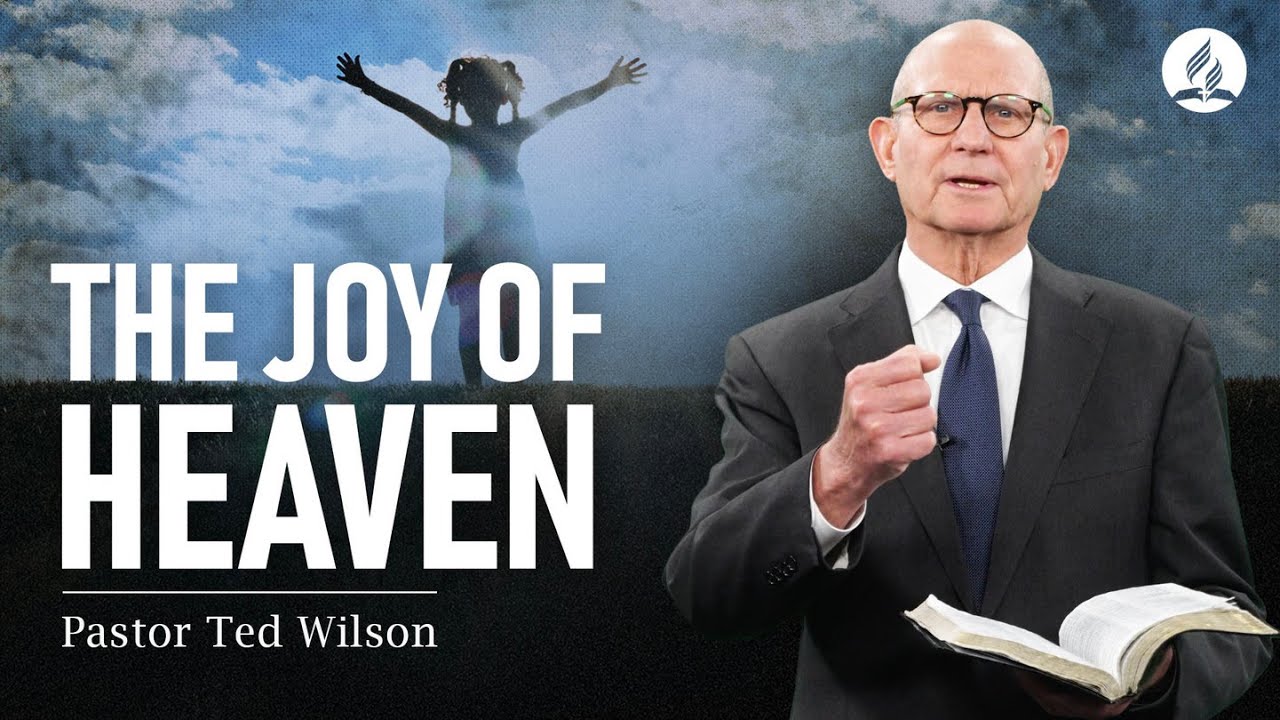
The Great Controversy Chapter 40: God’s People Delivered, Pt.4 | Pastor Ted Wilson

When Jesus returns, it will be a day of joy and salvation for many—but also a day of regret for those who have chosen to reject Him. In the Bible, we see heartbreaking scenes of people realizing they turned away from the only One who could save them.
But the good news is that it’s not too late. God’s invitation remains open, and He’s calling you to experience the joy of salvation.
Join Pastor Ted Wilson in this compassionate exploration of what happens to the lost and how you can embrace Christ’s love today.
Download your free copy of The Great Controversy at thegreatcontroversyproject.org.
Adventist News Network – March 14, 2025: Historic Pediatric Heart Transplant & More Global News

Adventist News Network – March 14, 2025: Historic Pediatric Heart Transplant & More Global News |
This week on ANN: |
· From building a church in southern Peru to a groundbreaking pediatric heart transplant in California, from a major youth congress in Africa to new academic programs in Brazil, Adventists worldwide continue to serve, innovate, and share hope.
· Stay tuned as ANN brings everything you have to know about what is happening in the church worldwide.
Lesson 12.Love and Justice: The Two Greatest Commandments | 12.1 The Two Greatest Commandments | THE GOD OF LOVE AND JUSTICE | LIVING FAITH


Lesson 12.Love and Justice: The Two Greatest Commandments
Love and Justice – God’s Highest Calling
Love and justice are the central values that run throughout the entire Bible. Jesus himself summarized the law in two commandments: to love God with all your heart and to love your neighbor as yourself (Matthew 22:37–39). These commandments are inseparable – whoever loves God will also love their fellow human beings and strive for justice.
Yet, human history shows that this is often neglected. Idolatry and lovelessness are among the greatest sins because they destroy the relationship with God and with others. The prophets repeatedly called for repentance, advocating for mercy and social justice. Jesus also lived and taught that true piety is not just about prayers and rituals but is expressed in active love for others and a commitment to justice.
This lesson challenges us to examine our own lives:
 Where does my heart belong – to God or to other “idols”?
Where does my heart belong – to God or to other “idols”?
 Am I truly a neighbor to those around me?
Am I truly a neighbor to those around me?
 Do I actively stand up for justice, or do I overlook injustice?
Do I actively stand up for justice, or do I overlook injustice?
Faith without love is empty. This lesson invites us not only to consider love and justice as theories but to consciously live them out in our daily lives – just as Jesus showed us.

12.1 The Two Greatest Commandments
Love for God and People as the Foundation of Our Lives
Read Matthew 22:34–40. How does Jesus answer the question of the teacher of the law?
Jesus’ response to the teacher of the law reveals that love is the foundation of God’s commandments. Love for God and love for one’s neighbor are not merely two separate commandments but the very essence of the entire law. Jesus makes it clear that true justice and a life pleasing to God emerge from this love.
These two commandments are inseparably linked: Whoever truly loves God will also love their neighbor—and vice versa. Love for God is not only expressed in worship and prayer but also in how we treat others. At the same time, love for one’s neighbor finds its deepest meaning when it flows from love for God.
Interestingly, Jesus quotes these commandments from the Old Testament (Deuteronomy 6:5; Leviticus 19:18). This demonstrates that God’s will has remained the same throughout history: He calls us to live in a relationship of love with Him and with our fellow human beings.
The challenge for us today is to put these commandments into practice in everyday life. How can we reflect God’s love in tangible ways? How can we advocate for justice? It starts with small decisions—kindness, forgiveness, helpfulness, and the courage to stand for truth and righteousness.
Ultimately, Jesus calls us to go beyond legal requirements and to root our lives in love. This is not merely a theoretical teaching but a practical lifestyle that should shape our thinking, speaking, and actions.
Read Matthew 19:16–23. How are Jesus’ responses to the rich young man in this passage connected to His answer to the teacher of the law in Matthew 22?
The encounter between Jesus and the rich young man (Matthew 19:16–23) is closely linked to His response to the teacher of the law in Matthew 22:34–40. Both situations center around the nature of the law and the path to eternal life—and in both cases, Jesus reveals the core of the law: Love for God and love for one’s neighbor.
What happened here?
The young man in Matthew 19 sought a specific action that would secure him eternal life. Jesus first points him to the Ten Commandments, particularly those that deal with interpersonal relationships. But when the man insists that he has already kept these commandments, Jesus challenges him to sell everything he owns and give it to the poor. This was a test—was he truly willing to live out the second greatest commandment, “Love your neighbor as yourself,” without compromise?
Here lies the connection to Matthew 22: Love for God and love for others is not just a theoretical concept—it requires concrete actions. For this man, it meant giving up his wealth and helping others. However, he could not part with his possessions. His heart clung more to material things than to God.
Why did Jesus give him this answer?
Jesus saw that the man’s wealth was his greatest spiritual barrier. His outward religious observance masked an inner reliance on his possessions rather than on God. By instructing him to give everything away, Jesus exposed the true state of his heart.
This challenge applies not only to him but to all people, regardless of social status or material wealth:
-
Examine the heart – Each of us may have things that unconsciously separate us from God, whether wealth, career, recognition, or personal ambitions.
-
Put love into action – True love is not just words or religious duties but selfless devotion to God and others.
-
Let go of personal “wealth” – Jesus calls us to release anything—material, emotional, or spiritual—that weakens our relationship with God.
What does this mean for us?
Jesus’ words challenge us to evaluate our hearts: What is the one thing that keeps us from fully loving God?
For some, it is money; for others, pride, comfort, or fear.
Ultimately, this is not just about external commandments but about complete devotion to God. Only when we are willing to let go of our “treasures” can we truly be free—free to love God with all our hearts and to treat our neighbors as Jesus did.
Even if we are not all called to sell everything we own like the rich young man, what might we cling to that could lead to our eternal ruin if we do not let it go?
The story of the rich young man shows that it is not only material wealth that can separate us from God. Every person has something they hold onto—whether possessions, personal ambitions, specific relationships, or deeply rooted fears. The key question is:
What takes up the space in my heart that rightfully belongs to God?
Here are some common obstacles that can become spiritual dangers if not surrendered:
-
Material wealth and financial security – Not only extreme riches but also the desire for financial security can weaken our trust in God.
-
Pride and self-will – The need to control everything, always be right, or never admit mistakes can make us resistant to God’s guidance.
-
Fear and worry – When we cling to fears or insecurities, it can be hard to truly trust God.
-
Relationships or social acceptance – When the fear of losing people’s approval is greater than our love for God, we may struggle to follow Him fully.
-
Sinful habits – Things like envy, bitterness, unforgiveness, pride, greed, or unhealthy lifestyles can keep us from experiencing God’s love.
What can we do?
The Bible urges us to let go of everything that separates us from God (Hebrews 12:1-2). This doesn’t mean becoming poor or withdrawing from the world, but rather examining our hearts:
-
What is more important to me than God?
-
What am I afraid to let go of?
-
What prevents me from fully trusting God?
In the end, it comes down to a heart decision: Are we willing to put God first in everything? If so, He will help us let go—and bless us with true freedom, deep love, and a life filled with purpose.
The two greatest commandments—love for God and love for our neighbor—are not just spiritual principles but should shape our daily lives and faith. They serve as the foundation for our thoughts, actions, and decisions. But what does this look like in everyday life?
-
Love for God as a Life Foundation
In Matthew 22:37, Jesus commands us to love God with all our heart, soul, and mind. This means that our relationship with God should not be based on traditions or duties but on deep, genuine love.
-
In daily life, this means:
-
Taking time for prayer and Bible study to know God better.
-
Honoring God not just on Sundays but in every decision and situation.
-
Trusting God, even in difficult circumstances.
-
Love for God is reflected not only in personal spirituality but also in how we live—whether in our careers, families, or relationships.
-
Love for Others in Practical Life
Jesus makes it clear: Our love for God is demonstrated in how we treat others. The story of the rich young man in Matthew 19:16–23 shows that true love requires concrete actions.
-
In daily life, this means:
-
Kindness and patience – Choosing to be gentle and understanding, even in stressful moments.
-
Forgiveness and reconciliation – Treating others as Jesus would, even when it’s difficult.
-
Helping those in need – Caring not just about ourselves but actively supporting others.
-
Final Thought: A Lifestyle of Love
The teachings of Jesus in Matthew 22 and 19 are not just theological ideas but a direct call to live our faith daily. Love for God and love for our neighbor should be the standard for all our actions.
 Examine our hearts—are there things that separate us from God?
Examine our hearts—are there things that separate us from God?
 Live out love—through words and actions.
Live out love—through words and actions.
 Let God transform us—so His love fills us and flows through us to others.
Let God transform us—so His love fills us and flows through us to others.

True love for God is revealed in how we treat our fellow human beings.
16.03.2025 – 2 Peter Chapter 2 | BELIEVE HIS PROPHETS
March 16, 2024
DAILY BIBLE READING – 2 Peter Chapter 2
1 But there were false prophets also among the people, even as there shall be false teachers among you, who privily shall bring in damnable heresies, even denying the Lord that bought them, and bring upon themselves swift destruction.
2 And many shall follow their pernicious ways; by reason of whom the way of truth shall be evil spoken of.
3 And through covetousness shall they with feigned words make merchandise of you: whose judgment now of a long time lingereth not, and their damnation slumbereth not.
4 For if God spared not the angels that sinned, but cast them down to hell, and delivered them into chains of darkness, to be reserved unto judgment;
5 And spared not the old world, but saved Noah the eighth person, a preacher of righteousness, bringing in the flood upon the world of the ungodly;
6 And turning the cities of Sodom and Gomorrha into ashes condemned them with an overthrow, making them an ensample unto those that after should live ungodly;
7 And delivered just Lot, vexed with the filthy conversation of the wicked:
8 (For that righteous man dwelling among them, in seeing and hearing, vexed his righteous soul from day to day with their unlawful deeds;)
9 The Lord knoweth how to deliver the godly out of temptations, and to reserve the unjust unto the day of judgment to be punished:
10 But chiefly them that walk after the flesh in the lust of uncleanness, and despise government. Presumptuous are they, selfwilled, they are not afraid to speak evil of dignities.
11 Whereas angels, which are greater in power and might, bring not railing accusation against them before the Lord.
12 But these, as natural brute beasts, made to be taken and destroyed, speak evil of the things that they understand not; and shall utterly perish in their own corruption;
13 And shall receive the reward of unrighteousness, as they that count it pleasure to riot in the day time. Spots they are and blemishes, sporting themselves with their own deceivings while they feast with you;
14 Having eyes full of adultery, and that cannot cease from sin; beguiling unstable souls: an heart they have exercised with covetous practices; cursed children:
15 Which have forsaken the right way, and are gone astray, following the way of Balaam the son of Bosor, who loved the wages of unrighteousness;
16 But was rebuked for his iniquity: the dumb ass speaking with man’s voice forbad the madness of the prophet.
17 These are wells without water, clouds that are carried with a tempest; to whom the mist of darkness is reserved for ever.
18 For when they speak great swelling words of vanity, they allure through the lusts of the flesh, through much wantonness, those that were clean escaped from them who live in error.
19 While they promise them liberty, they themselves are the servants of corruption: for of whom a man is overcome, of the same is he brought in bondage.
20 For if after they have escaped the pollutions of the world through the knowledge of the Lord and Saviour Jesus Christ, they are again entangled therein, and overcome, the latter end is worse with them than the beginning.
21 For it had been better for them not to have known the way of righteousness, than, after they have known it, to turn from the holy commandment delivered unto them.
22 But it is happened unto them according to the true proverb, The dog is turned to his own vomit again; and the sow that was washed to her wallowing in the mire.
King James Version. Public Domain
Commentary
Introduction
2 Peter Chapter 2 is a powerful warning against false teachers and their destructive influence on the church. Peter compares these deceivers to the false prophets of the Old Testament, describing their corrupt nature, greed, and deceptive behavior. He emphasizes that God is not only able to preserve the righteous but also to punish the wicked. Historical examples—fallen angels, the flood, Sodom, and Gomorrah—serve as evidence of God’s judgment. The message is clear: those who knowingly turn away from the truth and lead others astray will face a harsher punishment than those who never knew the truth. This chapter urges Christians to remain vigilant and not be misled by teachings that appear attractive but are ultimately deceptive.
Commentary
-
The Warning Against False Teachers (Verses 1–3)
Peter begins by stating that false teachers will infiltrate the church. They introduce destructive heresies and deny Christ, the very Lord who redeemed them. Through their sinful lives and deceptive words, they lead many astray, causing the “way of truth” to be maligned. Their motivation is greed—they seek material and personal gain. This warning reminds us that false teachings are often subtle and may not be immediately recognizable, slowly creeping into the community of believers.
-
God’s Judgment on the Ungodly (Verses 4–10a)
Peter provides three historical examples of God’s judgment:
-
The fallen angels were cast into darkness.
-
The sinful world of Noah’s time was judged, while Noah, a preacher of righteousness, was preserved.
-
Sodom and Gomorrah were destroyed, while Lot, a righteous man, was rescued.
These examples make it clear that God not only punishes the wicked but also protects His faithful ones. Verse 9 summarizes this: “The Lord knows how to rescue the godly from trials and to keep the unrighteous under punishment until the day of judgment.”
-
The Corrupt Nature of False Teachers (Verses 10b–16)
Peter describes false teachers as arrogant, rebellious, and driven by their fleshly desires. They despise authority and are bold in their wrongdoing. Even angels, who possess greater power, do not act with such disrespect. Their behavior is likened to animals that follow their instincts blindly into destruction. A striking example is Balam, who loved the “wages of unrighteousness”—a prophet who was corrupted by greed and power until his own donkey had to rebuke him.
-
The Consequences of Deception (Verses 17–22)
Peter uses harsh imagery to describe these deceivers: they are “wells without water” and “clouds driven by a storm”—they promise life and refreshment but instead bring confusion and destruction. They speak of freedom while being slaves to sin themselves. Tragically, they lead astray those who have just escaped deception. Their end is worse than their beginning because they knew the truth and still returned to sin. The final comparison to a dog returning to its vomit and a pig wallowing in the mud illustrates the repulsiveness of their return to corruption.
Summary
2 Peter Chapter 2 is a serious warning about the destructive consequences of false teachings and a godless lifestyle. False teachers not only endanger themselves but also drag others into ruin. Peter makes it clear that God is just: He saves the righteous and judges the wicked. At the same time, he encourages believers to stay alert and not fall into the same deceptions. The passage strongly emphasizes that deliberately abandoning the truth is worse than ignorance—an urgent call for every Christian to remain faithful and steadfast in their faith.
![]()

WEEKLY SPIRIT OF PROPHECY READING – Ellen White | Steps to Christ
Chapter 9—The Work and the Life
Read online here
Commentary
Introduction
Chapter 9 describes God’s selfless love as the source of all life, light, and blessing. This principle of selfless devotion is evident throughout creation, but most especially in the life of Jesus Christ. His existence was marked by sacrifice—he lived to save humanity and set an example of love and service. His followers should adopt the same attitude: a life that does not seek self-fulfillment but instead places the well-being of others at its center. This service is not only a calling but also the path to true happiness and spiritual growth.
Commentary
1.The Source of All Life and Blessing
God is the origin of life and blessing, and everything that exists receives light and joy from Him. Just as sunlight and flowing water nourish all living things, so too should humans receive and share God’s blessings. True fulfillment in life does not come from seeking personal gain but from sharing God’s love with others.
2.Christ as the Ultimate Example of Service
Jesus Christ lived a completely selfless life. His greatest concern was to save fallen humanity, even at the cost of suffering and sacrifice. Likewise, angels were not created for themselves but to serve others. The very essence of heaven is not selfishness but sacrifice and love. Those who reject this mindset separate themselves from God.
3.The Impact of God’s Love in a Person
When Christ’s love dwells in a person’s heart, it cannot remain hidden. It radiates outward and influences all who come into contact with them. A Christian’s life should be like a fresh spring in the desert—bringing refreshment and life to those in need.
4.The Joy of Serving Others
The deepest expression of love for Christ is the desire to help others. This was the principle by which Jesus lived. His life was not one of comfort and ease but of tireless service. Those who follow Him will not focus on their own desires but on the well-being of others.
5.The Importance of Sacrifice
A true disciple of Jesus is willing to make sacrifices so that others may experience the blessing of salvation. This sacrifice can take the form of time, resources, or personal dedication. Those who have received God’s grace cannot keep it to themselves—they will feel compelled to share it with others.
6.Communion with Christ Through Service
Serving others not only brings blessings to the recipients but also to the one who serves. God could have entrusted His work of salvation to angels, but He chose to involve people so that their faith could be strengthened. Anyone who dedicates themselves to God’s service will grow deeper in their experience of His love and truth.
7.The Necessity of Spiritual Growth Through Service
Christian growth does not happen through passive receiving but through active giving. Those who do not live out their faith will lose it. But those who carry out God’s mission and serve others will grow spiritually. This is a divine principle: spiritual strength comes through active engagement.
8.Every Christian is Called to Serve
The Church of Christ is called to bring the Good News to the world. This task is not only for missionaries or preachers but for every believer. Each person can be a witness for Christ through their work, behavior, and relationships. Even those who cannot travel to distant lands can still contribute through prayer, support, and serving in their immediate surroundings.
9.Imitating Christ in Everyday Life
Jesus spent most of His earthly life engaged in everyday work as a carpenter. He demonstrated that every job and every activity can be an opportunity to serve God. Even a simple worker can bear witness to Christ through faithfulness and integrity. Everyone can be a light to those around them and lead others to faith.
10.The Blessing of Selfless Service
Many people believe they are not qualified to work for God’s kingdom, but God does not only call the most talented—He calls every believer. Even the simplest tasks, when done with love, are valuable in God’s kingdom. Those who are faithful in small things will also be entrusted with greater things.
11.No Excuses – Everyone Can Serve
Many wait for a “special opportunity” to serve God, but this is a mistake. The best opportunity is the present moment—by living faithfully, showing love in daily life, and being open to the needs of others. Those who make themselves available to Christ will experience how He uses them and how their lives bear fruit.
12.The Hidden Influence of Service
Some people do not see the visible results of their efforts and feel useless. But God sees everything and will bring hidden deeds to light. Often, the effects of our actions will only be revealed in eternity. Those who remain faithful will ultimately see that no selfless act of service was in vain.
Summary
Chapter 9 teaches that true joy and fulfillment are found in selfless service. God is the source of all blessings, and He desires for us to pass these blessings on to others. Jesus is the highest example of a life of dedication and service. Those who follow Him will not live for themselves but for the good of others.
God has given us the privilege of participating in His work of salvation. This is not only a duty but also a blessing for us. Serving others strengthens our faith, brings us closer to Christ, and fills us with deep joy. Every Christian is called to be a light to others through their work, testimony, and love.
The greatest growth in faith does not come from passivity but from active participation in God’s work. Those who share God’s blessings with others will be blessed themselves. But those who remain spiritually inactive will lose their faith. Therefore, this chapter calls us not to wait but to act immediately and wholeheartedly for Christ—whether in our own homes, churches, or the world.
Source: https://fulfilleddesire.net/16-03-2025-2-peter-chapter-2-believe-his-prophets/
- « Previous Page
- 1
- …
- 79
- 80
- 81
- 82
- 83
- …
- 689
- Next Page »


